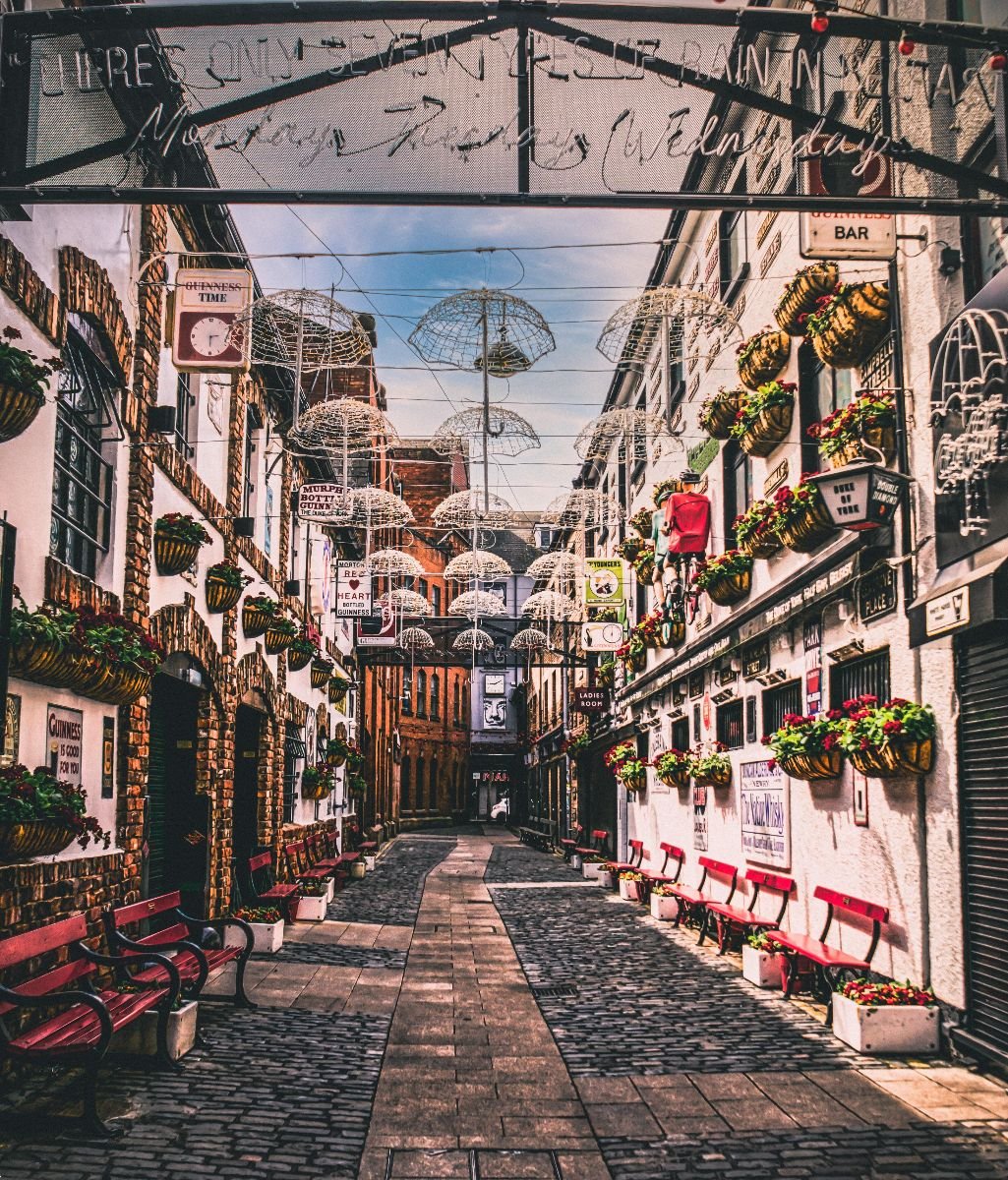Belfast || Poitín || Dyed Green
Photo of the courtyard outside the Duke of York pub in Belfast city center by K. Mitch Hodge.
Belfast is all over the news in the US this week–the movie, that is. Kenneth Branagh’s film was inspired by his childhood and has secured seven Oscar nominations, including Best Picture. It’s set in 1969 and told from the perspective of a young boy growing up during the so-called “Troubles,” and while I’ve seen some criticism from the other side of the pond with regard to how it engages (or doesn’t, as the case may be) the historical context, I doubt most American viewers will be inclined to notice either way.
Belfast is such a unique and exciting place, and one which we’ve been happy to have traveled to countless times over the last 20 years. It’s also where my maternal great-grandparents, Annie Erskine and James Sloan, are from. While the recent political conflict may have caused some travelers to stay in the south when visiting Ireland, the north is not to be missed. There are all sorts of opportunities to learn more about Belfast’s history, from walking tours to graveyard lectures to small community museums.
Did you know that the Titanic was built in Belfast? The Titanic Belfast museum opened in 2012 on the site of the former Harland & Wolff shipyard where the vessel was built. On the surface, it might sound strange to build a museum to a ship that sank (though there’s also one in Pigeon Forge, Tennessee, home of Dollywood), but at the turn of the (20th) century, Belfast was the global shipbuilder. No doubt the fascination with the Titanic story–not to mention the James Cameron film–keeps tourists coming to visit.
If you are a Game of Thrones fan, you probably already know that much of the series was shot in Northern Ireland. There are a lot of organized day trips that depart from Belfast city and go to Winterfell, the Iron Islands, the Dark Hedges, the cliffs of Dragonstone, and so on. The Game of Thrones studio tour also just opened in Banbridge, County Down, if you really want to take a deep dive.
There’s also tons of great food in Belfast. The St. George’s Market is one of our favorite spots to visit. It’s rare to find a market that has fresh caught local seafood, vegetables, antiques, and some delicious food stands - both trendy and traditional. Mike’s Fancy Cheese is a delightful cheese shop focusing on artisan cheesemakers. Ox is a stunning Michelin starred restaurant that uses local ingredients. There’s also more casual options like Toast Office, a super popular grilled cheese popup.
Max and Kate enjoying a pint at the Duke of York.
The first time I ever tried poitín, a traditional distilled Irish spirit sometimes referred to as “Irish moonshine”–or, as Max was delighted to discover, “mountain dew”–was at a bar in Belfast that shall remain nameless. It was given to me from a bartender’s secret stash behind the counter [Note to travelers: I would generally not advise taking free homemade booze from strangers in foreign bars, but at the time I was with locals and lived to tell about it!] with a warning that it would really put some hair on my chest. Apparently poitín distilling was legalized in Ireland in 1997 but remains illegal in Northern Ireland.
Back in the 1600s, when Ireland was under British colonial rule, the government attempted to collect a tax on the production of poitín, which led local distillers to hide their bottles. King Charles II declared it illegal in 1661, and it remained that way for more than three hundred years. Pádraic Ó Griallais, owner of Galway’s Micil Distillery, spoke to Wine Enthusiast about the outcome of the ban:
“It’s inextricably linked to Irish culture and pride, as it’s hard to separate the two,” says Ó Griallais. “Poitin is symbolic of Irish liberation and oppression at the same time. It was a drink that small farmers made that could help them pay the British landlords’ rent… It was a way for the Irish people to express their irreverence towards the colonial British Empire.”
Since the ban on poitín has been lifted, Irish distillers have slowly embraced its production, and in 2008 the European Union gave it Geographical Indication status (meaning it must be produced on the island of Ireland).
A sneak peek at Dyed Green
In last week’s newsletter we shared the exciting news that we will be launching a podcast about Irish food and culture in March on the Heritage Radio Network. We are thrilled to share the logo for our new show, Dyed Green, which was created by Limerick-based artist Cathy Hogan. Let us know what you think!




